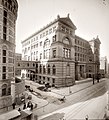American sculptor
Portrait of Domingo Mora, c. 1895 Domingo Mora (1840–1911) was a Spanish-American sculptor and architectural sculptor.
Career
Born in Catalonia, Spain , he studied sculpture in Barcelona and Madrid . He emigrated to Montevideo, Uruguay , where he married French-born Laura Gaillard. They had two sons, both of whom became artists – F. Luis Mora (1874–1940) and Jo Mora (1876–1947). In 1877 the family moved to the United States , and Mora became chief designer for the Perth Amboy Terra Cotta Company . There, he designed architectural sculpture for hundreds of buildings, including New York City's Metropolitan Opera House .[ 1] [ 2]
He was a member of the National Sculpture Society . Mora died in San Francisco, California , on July 24, 1911.[ 3]
Selected works
Bas-relief panels on facade, Metropolitan Opera House , Broadway & 39th Street, New York City, J. Cleaveland Cady , architect (1882–83, demolished 1967).
Reredos, All Saints Ashmont Episcopal Church, 209 Ashmont Street, Dorchester, Massachusetts , Ralph Adams Cram , architect (1892–93).[ 4]
Rotch reredos, Emmanuel Episcopal Church, Boston , designed by Francis R. Allen , architect, 1904.
Pedimental sculptures, New York Criminal Courts Building, Center & White Streets, New York City, Thom & Wilson , architects (1892–94, demolished ca.1939).
16 lifesize allegorical figures, Great Hall, Suffolk County Courthouse (now John Adams Courthouse), Pemberton Square , Boston, Massachusetts, George Albert Clough , architect (1893–94).[ 5]
Architectural ornament, Tremont Temple , 88 Tremont Street, Boston, Massachusetts, Clarence Blackall , architect (1895–96).
Architectural ornament, capitals and friezes on the George Walter Vincent Smith Art Museum , Springfield, Massachusetts (1895).
Bas-relief panels on facade, Congregational House (now Congregational Library & Archives ), 14 Beacon Street, Boston, Massachusetts, Shepley, Rutan and Coolidge , architects (1898).[ 6]
Ceiling frieze of Music Room, J. P. Morgan Library , 225 Madison Avenue, New York City, McKim, Mead & White , architects (1907).
Architectural sculpture, Newhall Building, 260 California Street, San Francisco, California, Lewis P. Hobart , architect (1908–10).
Bas-relief panels on façade, Orpheum Theatre (now Palace Theatre ), 620 S. Broadway, Los Angeles, California, G. Albert Lansburgh , architect (1911).[ 7]
Metropolitan Opera House, New York City (1882–83, demolished 1967).
Pedimental sculptures, New York Criminal Courts Building, New York City (1894, demolished ca.1939).
Tremont Temple interior, Boston, Massachusetts (1895–96).
Terra-cotta entryway to the
George Walter Vincent Smith Art Museum , in Springfield, Massachusetts (1895).
[ 8]
"Law" bas-relief panel,
Congregational Library & Archives , Boston, Massachusetts (1898).
"Troubador" bas-relief panel,
Palace Theatre , Los Angeles, California (1911).
References
^ Opitz, Glenn B., ‘’Mantle Fielding’s Dictionary of American Painters, Sculptors and Engravers’’, Apollo Books, Poughkeepsie, New York, 1988
^ Mitchell, Stephen, Jo Mora: Renaissance Man of the West . Stoecklein Publishing, Ketchum, Idaho, 1994, p.4
^ Kvaran & Lockley, A Guide to the Architectural Sculpture of the United States unpublished manuscript and website.
^ All Saints Ashmont. Archived January 9, 2013, at the Wayback Machine ^ The 16 caryatid figures are titled: Law, Temperance, Prudence, Justice, Fortitude, Punishment, Guilt, Equity, Right, Innocence, Reward, Wisdom, Religion, Virtue, Reason, and Legislation.
^ Congregational House Bas-reliefs [usurped] ^ Sandra A.B. Levis. "Broadway Historic Theater District: A walking tour sponsored by the Los Angeles Conservancy" (PDF) . Los Angeles Conservancy. ^ A Souvenir of the Art Museum of the City Library Association . Springfield, Mass: Clark W. Bryan & Co. 1895.
Sources
Oswald Spier, "Domingo Mora—A Sculptor in Clay," The Brickbuilder, An Architectural Monthly (Boston: Rogers & Manson, February 1912), pp. 28–32.[1]
International National People




![Terra-cotta entryway to the George Walter Vincent Smith Art Museum, in Springfield, Massachusetts (1895).[8]](http://upload.wikimedia.org/wikipedia/commons/thumb/2/26/George_Walter_Vincent_Smith_Art_Museum_-_Springfield%2C_MA_-_DSC03514.JPG/120px-George_Walter_Vincent_Smith_Art_Museum_-_Springfield%2C_MA_-_DSC03514.JPG)


